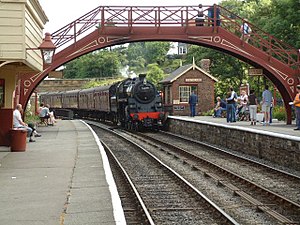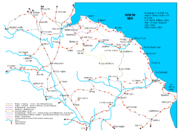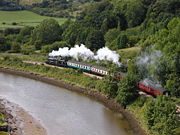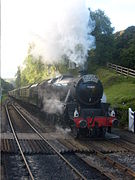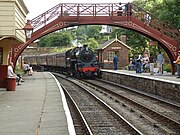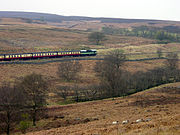Difference between revisions of "North Yorkshire Moors Railway"
(Created page with "{{Infobox heritage rail |name=North Yorkshire Moors Railway |county=Yorkshire |riding=North |picture=A4s 20080404 NYMR 040a.jpg |picture caption=Three LNER Class A4 locomotive...") |
|||
| (3 intermediate revisions by 2 users not shown) | |||
| Line 8: | Line 8: | ||
|gauge={{RailGauge|standard}} | |gauge={{RailGauge|standard}} | ||
|owned=North York Moors Historical Railway Trust Ltd | |owned=North York Moors Historical Railway Trust Ltd | ||
| − | |operator=North Yorkshire Moors Railway Enterprises plc | + | |operator=North Yorkshire Moors<br />Railway Enterprises plc |
|stations=6 | |stations=6 | ||
|length=18 miles | |length=18 miles | ||
| Line 14: | Line 14: | ||
|headquarters=[[Pickering]] | |headquarters=[[Pickering]] | ||
}} | }} | ||
| − | The '''North Yorkshire Moors Railway''' is a heritage railway in the [[North Riding of Yorkshire | + | The '''North Yorkshire Moors Railway''' is a heritage railway in the [[North Riding of Yorkshire]]. The line was first opened as a commercial line in 1836 as the Whitby and Pickering Railway, the railway. It was planned in 1831 by George Stephenson as a means of opening up trade routes inland from the then important North Riding seaport of [[Whitby]]. |
The line closed in 1965 and was reopened in 1973 by the North York Moors Historical Railway Trust Ltd. The preserved line is now a significant tourist attraction and has been awarded many industry accolades. | The line closed in 1965 and was reopened in 1973 by the North York Moors Historical Railway Trust Ltd. The preserved line is now a significant tourist attraction and has been awarded many industry accolades. | ||
| Line 28: | Line 28: | ||
==History== | ==History== | ||
| − | The North Yorkshire Moors Railway was first opened in 1836 as the Whitby and Pickering Railway. The railway was planned in 1831 by George Stephenson as a means of opening up trade routes inland to [[Whitby]]. The initial railway was designed and built to be used by horse-drawn carriages. Construction was carried out by navvies and coordinated by top engineers. Their three main achievements were cutting a 120 yard tunnel through rock at [[Grosmont]], constructing a rope-worked incline system at [[Beck Hole]] and traversing the marshy and deep [[Fen Bog]] using a bed of timber and sheep fleeces. The tunnel is believed to be one of the oldest railway tunnels in the world. In its first year of operation, the railway carried 10,000 tons of stone from Grosmont to Whitby, as well as 6,000 passengers, who paid a fare of 1 shilling to sit on the roof of a coach, or 1 shilling and 3 pence to sit inside. It took two and a half hours to travel from Whitby to Pickering. | + | The North Yorkshire Moors Railway was first opened in 1836 as the Whitby and Pickering Railway. The railway was planned in 1831 by George Stephenson as a means of opening up trade routes inland to [[Whitby]]. The initial railway was designed and built to be used by horse-drawn carriages. Construction was carried out by navvies and coordinated by top engineers. Their three main achievements were cutting a 120-yard tunnel through rock at [[Grosmont]], constructing a rope-worked incline system at [[Beck Hole]] and traversing the marshy and deep [[Fen Bog]] using a bed of timber and sheep fleeces. The tunnel is believed to be one of the oldest railway tunnels in the world. In its first year of operation, the railway carried 10,000 tons of stone from Grosmont to Whitby, as well as 6,000 passengers, who paid a fare of 1 shilling to sit on the roof of a coach, or 1 shilling and 3 pence to sit inside. It took two and a half hours to travel from Whitby to Pickering. |
In 1845, the railway was acquired by the York and North Midland Railway who re-engineered the line to allow the use of steam locomotives. They also constructed the permanent stations and other structures along the line which still remain today. The Beck Hole Incline was re-equipped with a steam powered stationary engine and iron rope. They also added the line south from Pickering so that the line had a connection to [[York]] and [[London]]. | In 1845, the railway was acquired by the York and North Midland Railway who re-engineered the line to allow the use of steam locomotives. They also constructed the permanent stations and other structures along the line which still remain today. The Beck Hole Incline was re-equipped with a steam powered stationary engine and iron rope. They also added the line south from Pickering so that the line had a connection to [[York]] and [[London]]. | ||
| Line 44: | Line 44: | ||
*[[Pickering]] station is the current terminus of the railway and serves the busy market town of Pickering. The station has been restored to its 1937 condition with help from the Heritage Lottery Fund. Original fixtures and fittings have been installed in the Booking Office and Parcels Office, as well as in the Tea Room. A park-and-ride service is provided to keep traffic out of the town during busy periods. | *[[Pickering]] station is the current terminus of the railway and serves the busy market town of Pickering. The station has been restored to its 1937 condition with help from the Heritage Lottery Fund. Original fixtures and fittings have been installed in the Booking Office and Parcels Office, as well as in the Tea Room. A park-and-ride service is provided to keep traffic out of the town during busy periods. | ||
| − | At Pickering station are the railway's carriage workshops, and there is also a turntable. Originally the station had an overall roof designed by the architect G T Andrews. This roof was removed by British Railways in 1952 due to corrosion. A replacement roof was fitted to the station between January - April 2011, as part of the North Yorkshire Moors Railway's 'Train of Thought' project.<ref>http://www.thetrainofthought.co.uk/</ref> Other work includes a Learning Centre and a Visitor Centre behind the down platform. Originally, the line continued south of Pickering to join the [[Malton, Yorkshire|Malton]] to [[Scarborough]] line at Rillington Junction but this track has since been lifted with the last trip to Malton running on 1 July 1966, the day the freight services were withdrawn. | + | At Pickering station are the railway's carriage workshops, and there is also a turntable. Originally the station had an overall roof designed by the architect G T Andrews. This roof was removed by British Railways in 1952 due to corrosion. A replacement roof was fitted to the station between January - April 2011, as part of the North Yorkshire Moors Railway's 'Train of Thought' project.<ref>[http://www.thetrainofthought.co.uk/ The Train of Thought project]</ref> Other work includes a Learning Centre and a Visitor Centre behind the down platform. Originally, the line continued south of Pickering to join the [[Malton, Yorkshire|Malton]] to [[Scarborough]] line at Rillington Junction but this track has since been lifted with the last trip to Malton running on 1 July 1966, the day the freight services were withdrawn. |
*[[Farwath]] station was a small railway halt located between both Pickering and Levisham, however the halt is currently closed and demolished. | *[[Farwath]] station was a small railway halt located between both Pickering and Levisham, however the halt is currently closed and demolished. | ||
| Line 70: | Line 70: | ||
In March 2009, the railway announced that one of its bridges near Goathland needed to be repaired/replaced over the winter of late-2009/early-2010, otherwise the railway would be forced to close. The railway therefore launched an appeal to raise £1 million to cover the costs of the bridge work with any excess raised going towards the restoration of locomotive 80135. The money was raised in time, and the bridge was replaced over the winter-Christmas/new year period of late-2009/early-2010, with the first trains crossing over the new bridge in late March 2010. | In March 2009, the railway announced that one of its bridges near Goathland needed to be repaired/replaced over the winter of late-2009/early-2010, otherwise the railway would be forced to close. The railway therefore launched an appeal to raise £1 million to cover the costs of the bridge work with any excess raised going towards the restoration of locomotive 80135. The money was raised in time, and the bridge was replaced over the winter-Christmas/new year period of late-2009/early-2010, with the first trains crossing over the new bridge in late March 2010. | ||
| − | However, the next bridge located a few | + | However, the next bridge located a few yards between the tunnel & level crossing at Grosmont is likely to be the next in line for replacement according to a source on the BBC's Look North report. |
==Special events== | ==Special events== | ||
Latest revision as of 20:33, 6 May 2021
| North Yorkshire Moors Railway | |
|
Yorkshire | |
|---|---|
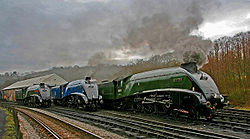 Three LNER Class A4 locomotives at Grosmont | |
| Gauge: | standard |
| No. of stations: | 6 |
| Track: | 18 miles |
| Headquarters: | Pickering |
| Information | |
| Operated by: | North Yorkshire Moors Railway Enterprises plc |
| Website: | nymr.co.uk |
The North Yorkshire Moors Railway is a heritage railway in the North Riding of Yorkshire. The line was first opened as a commercial line in 1836 as the Whitby and Pickering Railway, the railway. It was planned in 1831 by George Stephenson as a means of opening up trade routes inland from the then important North Riding seaport of Whitby.
The line closed in 1965 and was reopened in 1973 by the North York Moors Historical Railway Trust Ltd. The preserved line is now a significant tourist attraction and has been awarded many industry accolades.
Contents
Overview
The NYMR carries more passengers than any other heritage railway in the United Kingdom and may be the busiest steam heritage line in the world, carrying around 350,000 passengers in 2009.[1]} The line is 18 miles long, and the railway is the second-longest standard gauge heritage line in the United Kingdom (after the West Somerset Railway) and runs across the North York Moors from Pickering via Levisham, Newton Dale, Goathland and terminating at Grosmont.
Some heritage rail operations continue along Network Rail tracks to Whitby. The railway is formed from the middle section of the former Whitby, Pickering and Malton line which was closed in 1965 as part of the Beeching Axe.
The NYMR is owned by the North York Moors Historical Railway Trust Ltd (a charity and accredited museum) and is operated by its wholly owned subsidiary North Yorkshire Moors Railway Enterprises plc. It is mostly operated and staffed by volunteers.
Trains run every day from the beginning of April to the end of October and on weekends and selected holidays during the winter (with no service from 24–27 December). Trains are mostly steam-hauled; however in some cases heritage diesel is used. At the height of the running timetable, trains depart hourly from each station. As well as the normal passenger running, there are dining services on some evenings and weekends. The extension of steam operated services to the seaside town of Whitby has proven extremely popular.
History
The North Yorkshire Moors Railway was first opened in 1836 as the Whitby and Pickering Railway. The railway was planned in 1831 by George Stephenson as a means of opening up trade routes inland to Whitby. The initial railway was designed and built to be used by horse-drawn carriages. Construction was carried out by navvies and coordinated by top engineers. Their three main achievements were cutting a 120-yard tunnel through rock at Grosmont, constructing a rope-worked incline system at Beck Hole and traversing the marshy and deep Fen Bog using a bed of timber and sheep fleeces. The tunnel is believed to be one of the oldest railway tunnels in the world. In its first year of operation, the railway carried 10,000 tons of stone from Grosmont to Whitby, as well as 6,000 passengers, who paid a fare of 1 shilling to sit on the roof of a coach, or 1 shilling and 3 pence to sit inside. It took two and a half hours to travel from Whitby to Pickering.
In 1845, the railway was acquired by the York and North Midland Railway who re-engineered the line to allow the use of steam locomotives. They also constructed the permanent stations and other structures along the line which still remain today. The Beck Hole Incline was re-equipped with a steam powered stationary engine and iron rope. They also added the line south from Pickering so that the line had a connection to York and London.
In 1854 the York and North Midland Railway became part of the North Eastern Railway. Steam locomotives could not operate on the Beck Hole incline; so in the early 1860s the North Eastern Railway started construction of an alternative route which opened in 1865 – this is the route which is still in use today. The original route is now a 3½-mile rail trail.
In 1923 the North Eastern Railway was absorbed into the London and North Eastern Railway as a result of the Railways Act 1921. In 1948 nationalisation meant that British Railways took control. During this time, little changed on the line. However, in his controversial report Dr Beeching declared that the Whitby-Pickering line was uneconomic and listed it for closure; the last passenger service ran on 6 March 1965 with freight continuing until July 1966. The line was used in June 1965 to house the Royal Train for the Duke of Edinburgh's visit to the RAF Fylingdales early warning station.
In 1967, the North Yorkshire Moors Railway Preservation Society was formed, and negotiations began for the purchase of the line. After running various Open Weekends and Steam Galas during the early 1970s (by permission of British Railways) the Preservation Society transformed itself into a Charitable Trust (to ensure the future of the railway) and became The North York Moors Historical Railway Trust Ltd. Purchase of the line was completed and the necessary Light Railway Order obtained, giving powers to operate the railway. The railway was able to reopen for running in 1973 as the North Yorkshire Moors Railway, with much of the traction provided by the North Eastern Locomotive Preservation Group.
The preserved line is now a significant tourist attraction and has been awarded many industry accolades.
Stations
- Pickering station is the current terminus of the railway and serves the busy market town of Pickering. The station has been restored to its 1937 condition with help from the Heritage Lottery Fund. Original fixtures and fittings have been installed in the Booking Office and Parcels Office, as well as in the Tea Room. A park-and-ride service is provided to keep traffic out of the town during busy periods.
At Pickering station are the railway's carriage workshops, and there is also a turntable. Originally the station had an overall roof designed by the architect G T Andrews. This roof was removed by British Railways in 1952 due to corrosion. A replacement roof was fitted to the station between January - April 2011, as part of the North Yorkshire Moors Railway's 'Train of Thought' project.[2] Other work includes a Learning Centre and a Visitor Centre behind the down platform. Originally, the line continued south of Pickering to join the Malton to Scarborough line at Rillington Junction but this track has since been lifted with the last trip to Malton running on 1 July 1966, the day the freight services were withdrawn.
- Farwath station was a small railway halt located between both Pickering and Levisham, however the halt is currently closed and demolished.
- Levisham station is a small countryside station set in the scenic Newton Dale valley. The location of the station is notable, as it is nearly two miles from the village which it serves, and whose name it takes. The area is ideal for walking and a wide variety of wildlife and flowers can be found within a short distance of the station. Levisham Station has been renovated and preserved to represent a small NER country station, circa 1912. The station has a traditional camping coach, which is let for holidays. Since 2007 the North Yorkshire Moors Railway’s Artist in Residence Christopher Ware can be seen at work in an open studio at the station which is open every day when trains are running, and often when they are not (see the website).
- Newton Dale Halt is a remote walkers' request stop. There are excellent walks and beautiful scenery within easy reach.
- Goathland station is another typical countryside station, almost unchanged since its construction in 1865. The station has been restored to represent an NER country station post First World War circa 1922. The station is popular with tourists due to its appearances in Yorkshire TV's Heartbeat and the first of the Harry Potter films. The station has a newly refurbished Tea Room which is inside a Goods Warehouse. The station also has a traditional camping coach, which is let for holidays.
- Grosmont station was the railway's permanent northern terminus until 2007, when trains began operating into Whitby on a regular basis. The locomotive sheds are here, just south of the tunnel through which trains run en route for Goathland and beyond.
The station itself has been restored to the British Railways style circa 1952. It has full facilities including a shop, café serving cooked meals, toilets including disabled, a ticket office and a waiting room. The shed area has facilities to provide water and coal for the engines, as well as stabling. The 'running shed' is usually open to public access at one end, where stationary engines can be viewed. These are usually either operational but not in service that day, or undergoing light repair work. Also open to the public is the 'deviation shed' which houses locomotives and stock owned by NELPG as well as a small display about the history of the organisation. A number of other sheds not available for public access are used for the maintenance and overhaul of the engines. At Grosmont, the line connects with the Network Rail operated Esk Valley Line, where passengers may change trains to travel to the coast at Whitby, or inland to Middlesbrough and the rest of the national network. Thus, platform one of the station is served by Northern Rail services, whilst platforms two, three and four are used by the North Yorkshire Moors Railway.
- Whitby station is, on many operating days, the railway's northern terminus. All but two of the various timetables see steam trains operating through from Pickering, including daily throughout July and August except on Sundays. When North Yorkshire Moors Railway trains terminate at Grosmont rather than Whitby at off-peak times, connecting trains with Northern Rail are usually available at Grosmont, allowing passengers to begin their journey at Whitby and board a steam engine at Grosmont through to Goathland or Pickering. Limited facilities are available at Whitby station itself, and to run around its train all passengers must be detrained and the locomotive must propel (push) the coaching stock out of the station into a siding with a run round loop by the old engine shed, then run round before propelling the stock back into the station with the locomotive at the Grosmont end of the train, ready to depart.
Future and possibility of expansion
The possibility of reopening the 'missing 8-mile section' between Malton via Rillington Junction (on the York – Malton – Scarborough line) and Pickering has often been discussed.
This might allow the running of steam services from York to Whitby again (or even Scarborough to Whitby, if the short lived curve towards Scarborough were reinstated too). To achieve this would require considerable engineering work, not least in getting out of Pickering where a new road and several houses have been built on the track bed, just north of Kirby.
Reinstating this missing rail link was adopted as a policy objective by the council some years ago and with reservations supported by the North Yorkshire Moors Railway board.
Bridge & Wheels Appeal
In March 2009, the railway announced that one of its bridges near Goathland needed to be repaired/replaced over the winter of late-2009/early-2010, otherwise the railway would be forced to close. The railway therefore launched an appeal to raise £1 million to cover the costs of the bridge work with any excess raised going towards the restoration of locomotive 80135. The money was raised in time, and the bridge was replaced over the winter-Christmas/new year period of late-2009/early-2010, with the first trains crossing over the new bridge in late March 2010.
However, the next bridge located a few yards between the tunnel & level crossing at Grosmont is likely to be the next in line for replacement according to a source on the BBC's Look North report.
Special events
The Railway runs several special events through the year, usually revolving around a particular theme.
- Steam and Diesel Galas are weekend events (sometimes extended to Friday and/or Monday) popular with heritage railway enthusiasts. On these days, a full timetabled service is run alongside extra trains, such as local shuttle services and demonstration freight trains. The LNER Gala in April 2008 (which featured all three of the UK's operational Gresley A4 pacifics) attracted over 12,000 visitors from across the globe.
- The War-Time Weekend is a demonstration of the operation of railways in the UK during the Second World War. The stations are decorated to appear as they would in war time: sandbags are used around entrances, windows are taped up and station names are covered. Many period re-enactors attend in military or civilian costume to add to the authenticity. Periodic entertainment takes place, and there are events such as mock air-raids. Usually a period dance and a military parade will take place; also a wreath is laid in memory of those railwaymen who have died in service as a result of war.
- Santa Special trains are run in the Christmas period, complete with Elves, Santa's Grotto, presents and mince pies. The winter scenery of the North Yorkshire Moors adds to the charm of these events.
Other special events include a Vintage Vehicle Weekend, Music on the Moors and a Wizard Weekend.
Television and film appearances
The railway has been seen both on television and in film, including:
- Goathland Station has been used as both Hogsmeade Station in the Harry Potter films, and Aidensfield in the popular sixties drama Heartbeat.
- Pickering Station was used in the 2002 film Possession and Keeping Mum.
- Other appearances include Casualty, Brideshead Revisited, All Creatures Great and Small, The Royal, Poirot and Sherlock Holmes television series.
The railway has also featured in the documentary Yorkshire Steam which ran for two series on local television and in the second series of Great British Railway Journeys. Goathland station features on the 1985 music video for Simply Red's Holding Back the Years.
The railway also appeared in a "Thomas and Friends" learning Segment, with LNER Class A4 4498 Sir Nigel Gresley.
Pictures
|
Outside links
| ("Wikimedia Commons" has material about North Yorkshire Moors Railway) |
References
- ↑ NYMRHT Report and Accounts 2009
- ↑ The Train of Thought project
- NYMR Guide to the Line Booklet
